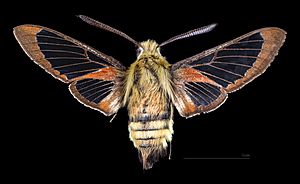Rocky Mountain clearwing facts for kids
Quick facts for kids Rocky Mountain clearwing |
|
|---|---|
 |
|
| Male dorsal | |
 |
|
| Male dorsal | |
| Scientific classification | |
| Genus: |
Hemaris
|
| Species: |
thetis
|
| Synonyms | |
|
|
The Rocky Mountain clearwing or California clearwing (scientific name: Hemaris thetis) is a type of moth. It belongs to the Sphingidae family, which includes many large moths. This moth was first described by a scientist named Jean Baptiste Boisduval in 1855.
Contents
About the Rocky Mountain Clearwing Moth
This interesting moth is known for its clear wings. It flies during the day, which is unusual for many moths.
What Does It Look Like?
The Rocky Mountain clearwing moth has a wingspan of about 35 to 50 millimeters. That's about 1.4 to 2 inches wide. Its head and chest area are usually brownish-olive or olive-green.
The main part of its body, called the abdomen, is black or olive-green on top. Underneath, it's yellow with a wide yellow band. The wings have a thin brown border. The clear parts of the wings often have a cool steel-blue shine. Other parts of the wings can be dark brown to light brownish-orange. Each wing has a big see-through patch that covers most of its surface.
Where Does It Live?
You can find the Rocky Mountain clearwing moth in western North America. Its home range stretches from Colorado, New Mexico, Montana, Idaho, Wyoming, and Utah. It also lives west to California and north into British Columbia in Canada.
These moths prefer to live in mountainous areas. They like places near streams and in meadows.
Life Cycle and Diet
There is usually one generation of these moths each year. Adult moths are active from May to August. They fly around and drink nectar from different flowers. Some of their favorite flowers include Arctostaphylos uva-ursi (also known as bearberry) and various Lupinus species (lupines).
The young moths, called larvae or caterpillars, eat the leaves of Symphoricarpos species. These plants are commonly known as snowberry or coralberry.
See also
 In Spanish: Hemaris thetis para niños
In Spanish: Hemaris thetis para niños

